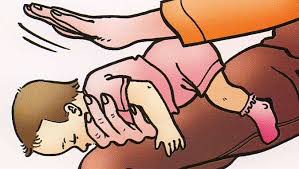Make sure you have read the first part, Parents and First-Aid for Babies.
In this entry, we will talk about choking, suffocation and strangulation and ways to deal with these emergencies.
The definition of choking is respiratory arrest following the internal obstruction of the airways. This is often caused by pieces of food or a small object (small, round, hard or crispy). Newborns can often have accumulations of thick secretions that can obstruct the airways and affect their respiratory capacity.
Suffocation is the obstruction of the airways by an external object that blocks the nose and mouth. For example, plastic bags, sheets or a mattress.
Strangulation is an external constriction of the neck that blocks breathing. This can be caused by a drape or clothing cord.
In utero, a baby’s airway is filled with secretions throughout pregnancy. During birth, the baby moves through the mother’s pelvis to be delivered through the vagina. Their thorax will be compressed which will get rid of most secretions in their airways. In the coming days, the newborn might regurgitate or vomit mucus or thicker strands of secretions. This will free up their airways, easing their breathing and gaseous exchanges.
What about a baby that is born via caesarian, one that doesn’t descend through their mother’s pelvis? Their thorax will not have been naturally compressed to get rid of the secretions. This explains why these babies have more postnatal secretions than others. As needed, caregivers will use a suction device with a tube to remove the newborn’s secretions to help clear their airways and breathe easier. The remaining secretions will be evacuated in the days following birth. You can help the process by using saline water and a nose pump, very effective tools.
Signs of Choking
1. If the obstruction is partial:
- The baby can cough, make sounds or cry;
- The baby’s skin is red;
- The perimeter of the mouth can turn bluish;
- The baby has difficulty breathing.
2. If the obstruction is complete:
- The baby is unable to cry;
- The baby doesn’t make sounds;
- The baby has difficulty breathing;
- Skin is red;
- The perimeter of the lips is blue;
- The baby looks distressed;
- They become unconscious.
What do you do if there is partial or complete obstruction?
 Look for an object in the baby’s mouth;
Look for an object in the baby’s mouth;
- Place your baby on their stomach on your left arm. Support their head with your left hand. Don’t block their mouth;
- Pushing upwards, slap their back 5 times;
- Turn them on their back on your right arm;
- Using two fingers, perform five chest thrusts under the intermammary line at a depth of 1.5 inches or 4 cm;
- Continue these steps until their airways are cleared or until they become unconscious.
To continue this topic, go to the next entry What to Do if the Baby Becomes Unconscious?


